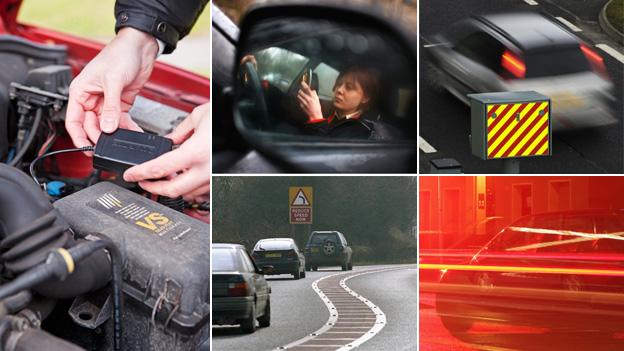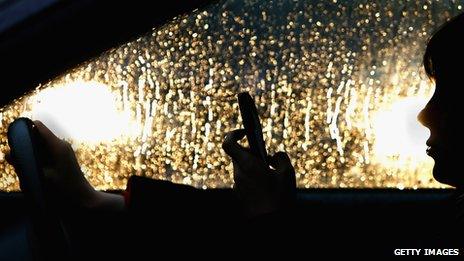The proliferation of the little black box
- Published

For a while, some insurance companies have been encouraging teenagers to get a little black box in their cars. But how do they work, and will everyone soon have one?
For many young people, getting their first wheels is a rite of passage, a path to independence, the precursor to flying the nest.
But with one in five young drivers having an accident within their first 12 months of being on the road, insurance premiums are high. Many look to ways to reduce their costs.
It has led to the rise of what is known as the little black box, which motorists are installing in their cars to prove they are a good driver, in the hope they see insurance costs drop.
The British Insurers Brokers' Association (Biba) says sales of motor insurance policies which use "black box" technology, called telematics, have increased fivefold over the past two years.
It says it can knock 25% to 30% off policies, saving some young drivers up to £1,000.
Critics say they cost too much and civil liberty campaigners have expressed concern about the potential for invasion of privacy, or data incriminating drivers.
So how does telematics technology work, and what do these black boxes record?
Typically the boxes are placed inside a dashboard and are able to monitor things such as speed, acceleration and braking, and the times of the day that the cars are on the roads.
The safer the driver, the better the score and the lower the insurance premium.
But prices can go up as well as down. If the analysed information shows examples of poor driving, such as fast cornering or doing wheelies, the black box will also pick that up.

Nick Moger, one of the founders of Young Marmalade, which offers a young driver insurance scheme with telematics technology, says his company uses a green-orange-red system to monitor driving, emailing drivers to alert them when they have picked up bad driving.
"The very first time, they get an email to say they are driving erratically, if they ignore that then they get another email to say you are on probation for 30 days and if they continue to drive badly we increase the premium by £250," he says.
Manufacturers are convinced highlighting poor driving patterns can improve driving behaviour and reduce the number of accidents.
"It has been proved in Italy - where they are probably the leaders in Europe in accident rates - their rate has dropped by 16% by having black boxes," says Moger.
More than 600,000 cars in Italy are believed to have the devices, many more than in the UK. But Biba expects 500,000 UK cars to have them by July 2014.
Nicole Darbyshire, a 20-year-old nursery nurse from Bolton, has already signed up to the system.
After passing her driving test in April, she says the cost of a car and its associated insurance was "a big worry" before she discovered that telematics could help reduce bills.
"For the first month, I was really aware of the box, and if I accidentally sped, I'd brake really quickly. Now I tend to forget it's there.
"I can log onto my account online and see how I am driving. It shows when I've over-accelerated - it has pictures of the street which is a bit strange. So far I've been 97% green, so that's good. I've got more relaxed about checking now as I know it will email me if I do anything wrong," she says.
But not everyone is so relaxed about signing up to this sort of surveillance.
Taylor Brown, 21, says he thinks his insurance company already has enough information. "Why should I then tell them what I'm getting up to - Big Brother Britain and that, but you know, it is up to me where I go."
Joe Johns, 18, doesn't like the idea either. "It would be like being on a driving test 24/7. You'd always have someone monitoring you about how you're driving, your foothold, your braking. I just wouldn't fancy it."
Firms such as Coverbox, iKube, Co-operative Insurance, Swinton and the AA now offer insurance schemes with telematics for young drivers.
The AA, which stores a small electronic box under the bonnet transmitting data via satellite to the company, says savings of up to £850 can be achieved when compared with standard inexperienced driver policies.
And the boxes aren't the only devices that incorporate artificial intelligence as an aid to monitor and control a young driver's behaviour.
Insurance firm Aviva has launched a new pay-how-you-drive smartphone app which could offer drivers savings on their car insurance premiums, based on how they drive.
Motoring journalist Paul Horrell says the devices are part of a wider trend that is seeing insurers and manufacturers try to incentivise or coerce young drivers into being more careful.
He cites a Ford product in the US called MyKey, which allows a master key to set various limits - such as maximum speed or audio - on the vehicle.
Volvo's Alcoguard monitors alcohol levels. It will not start until a driver has blown into a unit, which transmits the results via radio signal to the car's electronic control system. If a blood-alcohol limit of 0.2g/l is exceeded, the engine will not start.
And DriveCam, which was developed to help organisations with fleets of drivers, like haulage companies, monitor their drivers' performances, uses a system which relies on two cameras - one pointing at the road, and one monitoring the driver - to record instances of bad driving such as texting or tailgating.

So might everyone soon have a little black box, or something similar, in their car?
Horrell says it is often parents that are particularly attracted to devices such as little black boxes. But he thinks it is unlikely that everyone will subscribe to such surveillance.
"If people are willing to submit to this kind of observation, they are probably the kind of people who are willing to behave more responsibly."
Graeme Trudgill, head of corporate affairs at Biba, says although he expects to see a significant increase in the number of little black boxes in the young driver market over the next couple of years, it would not be economical for all insurance companies, and all age groups, to go down this route.
In many ways the future depends on technology, he says, as it depends on what happens with smartphone apps such as Aviva's, which are cheaper than having a box fitted. And in the next couple of years, vehicle manufacturers are also going to be required to install emergency call buttons, which will transmit GPS signals and have the potential to use telematics.
"What is clear is that we are definitely going to have more behaviour-based motor insurance in the future - and young drivers are going to still be the primary market," he says.
Adeola Ajayi, from the Association of British Insurers, says riskier or more dangerous drivers are likely to be the ones who are the most resistant.
She thinks there will be a spike in the number of young female drivers opting for a black box after 21 December, when an EU ruling which bans insurers from taking gender into account when setting premiums comes into effect.
"Female drivers, who are statistically safer, have benefited from cheaper insurance in the past, so these might prove popular with them.
"Others are simply keen to do whatever they can to get a premium that reflects their exact risk, and this is a way of getting more insight and rewarding customers," she says.
How Safe are Britain's Roads? is a two-part series on BBC Two starting Wednesday 31 October at 2100 GMT, or catch up on iPlayer